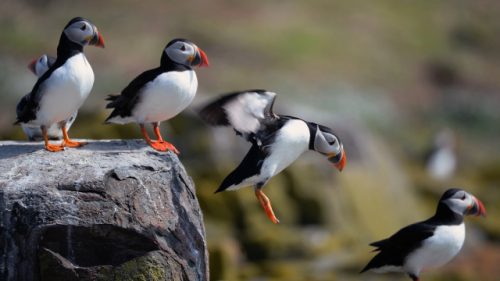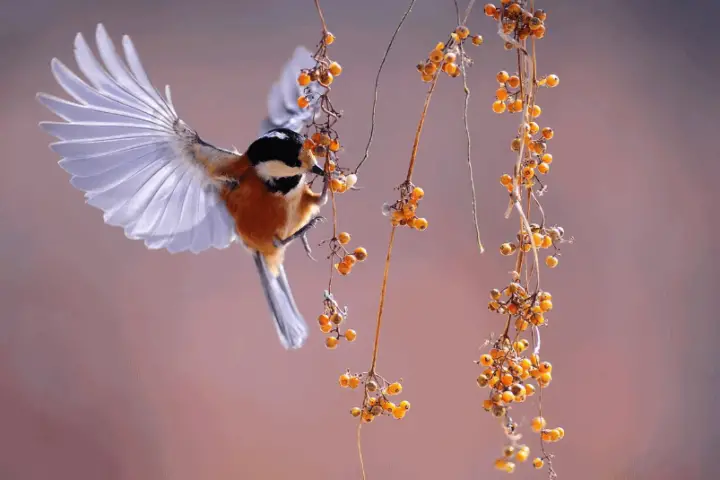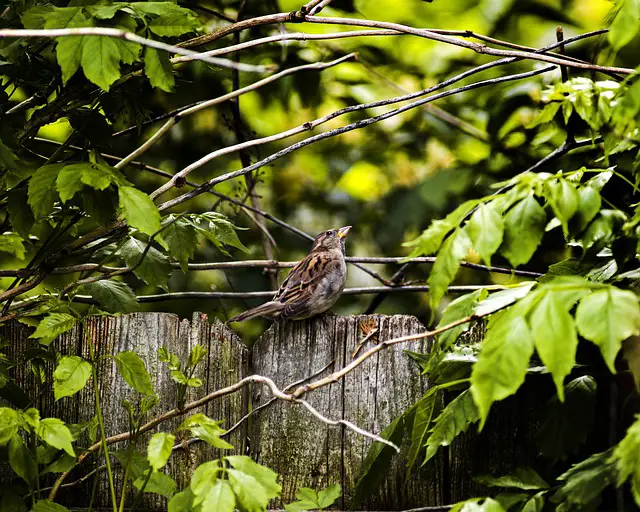The Atlantic puffin (Fratercula arctica) is a small and tough seabird and the only puffin species native to the Atlantic Ocean. It is thought to breed in Greenland, North Atlantic islands, Norway, and Newfoundland. Part of the bill and the legs are completely orange while the rest of plumage is greyish black to white in color.
Atlantic Puffin Facts
Anatomy
- Adult puffins reach a length of about 11–14.6 in (28–37 cm) and weighs up to 10.6–21.1 oz (300–600 g).
- Atlantic puffins have got one of the most colorful bills. It has bluish-gray base but as we proceed to the tip the color changes to yellow or orange. The tongue is yellow.
- They have snowy white underparts but the upper parts of completely black.
- Puffins have fairly small wings that are adapted to dive underwater but in the air they must flap their wings continuously to remain up.
- Males are larger than the females.
- During the breeding season, the color of the puffin’s bill goes even more colorful.
- They have got webbed paddle-like feet which gives an additional advantage while swimming. However on land, they are quite clumsy.
Geographic Range & Habitat
- Atlantic puffins are likely to breed all over the North Atlantic including European coast and American coast. They are also found in the eastern Mediterranean and Baltic Sea.
- Atlantic puffins gather in thousands on Iceland. Puffin’s range includes coast of Greenland, Faroe Islands, Newfoundland, Nova Scotia, Labrador, Maine, Orkney Islands, Russia, Novaya, and Zemlya.
- It goes as far as North Caroline and Mediterranean Sea.
- Puffins are the source of food for people living in Scandinavia.
- Atlantic puffins make homes on rocky coasts as well as on islands with suitable temperature. They are thought to dig burrows.

Behavior
- Outside the breeding season, Atlantic puffins love to fly and they rarely set their feet on land.
- They produce couple of different calls such as bellowing or
- Puffins are often seen in large numbers at sea along with other birds such as razorbills or murres.
- Atlantic puffins are highly sociable birds and they display many body gestures to communicate with their counterparts. It may even growl when threatened.
- They are brilliant divers as they are able to cover 150 inches in a single dive. This is unique among birds because only fish can have such a long horizontal dive.
- The bird rarely puts its head under water in order to find prey.
- Atlantic puffins fly 10 meters above the sea surface.
- They are generally silent birds.
- Puffins can also run on the water surface and during their run they may take off.
- They are thought to spend much of its day time on preening.
- The speed at which the Atlantic puffins fly is 80 kilometers (50 mi).
- Atlantic puffins mostly crash into a wave crest because it is unable land smoothly.
- During January and March puffins will lose their feathers.
Feeding Ecology & Diet
- Atlantic puffins typically feed on fish. The female puffin will collect many small fish in its bill to feed the chicks.
- Atlantic puffin’s diet consists of whitings, sand eels, polychaete worms, capeline, herring, rocklings, and sprats.
- They typically prey on four-inch long fish.
- Puffins may dive 50 inches deep down to catch fish.
- They supplement their diet with crustaceans, plankton-like animals, shrimp, and mollusks.
- They cannot catch fish while flying that is to say puffins must land before they prey on fish.

Reproductive Biology
- During the breeding season, both male and female tap their unusually large bills together. Mating occurs at sea.
- The breeding season ranges from April to August.
- A female puffin searches a far off place for nesting. She lays 1 – 2 eggs in a burrow and both parents incubate the eggs. The incubation lasts about 42 days. After 35 – 49 days, parents may not bring food back to the chicks.
- Puffin’s eggs average 61 millimeters (2.4 in) in length and weighs up to 62 grams (2.2 oz) and the width is about 42 millimeters (1.7 in).
- The chicks fledge in about 35 – 50 days. They weigh about 42 grams (1.5 oz) at birth but grow quickly each day.
- They nest on crags that are close to the seawater.
- They attain maturity at 5 – 6 years age.
- Atlantic puffins build nests with green vegetation.
- The average lifespan of Atlantic puffins is 10 – 15 years.
- Predators of Atlantic puffins are great black-backed gull, herring gull, lesser black-backed gull, stoats, dogs, foxes, cats, weasels, rats, and the great skua.





